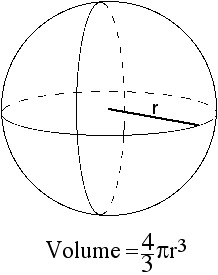
EXAMPLE 3.9.4
Gomer has been working out by lifting weights. He finds that a spherical lead-alloy weight with a radius of 3 inches weighs 20 pounds. He wishes to lift 100 pounds, so he special-orders a spherical weight with a radius of 15 inches. Why is Gomer in intensive care?
SOLUTION
Gomer is in intensive care because he tried to lift a weight that weighs much more than 100 pounds. To find the correct weight of the sphere that has the 15-inch radius, we can use the fact that the sphere with the 3-inch radius weighs 20 pounds to find the weight per cubic inch of one of these objects, and then apply that weigh factor to the 15-inch radius sphere. Recall the formula for the volume of a sphere:

The volume of the 3-inch radius sphere is
Now we find the number of pounds per cubic inch for the 20-pound weight: Next, find the volume of the larger, 15 inch radius sphere: Finally, multiply in order to find the correct weight of the larger sphere: Weight = (14,137.2 cu. in.)(0.177 pounds per cubic in.) = 2500.02 pounds Gomer thought that he was lifting a 100 pound weight, but in fact he was lifting a 2500 pound weight. The second weight wasn't 5 times heavier than the first weight. It was 125 times as heavy. This is because a sphere with a 15-inch radius is 125 times as large as a sphere with a 3-inch radius.
ALTERNATIVE SOLUTION![]()
![]()
![]()
Another way to arrive at this result is to compare the two spheres by dividing their volumes.
The volume of the larger spehere is (4/3)(pi)(153)
The volume of the smaller spehere is (4/3)(pi)(33)
Now divide:
(Volume of larger sphere)/(Volume of smaller sphere)
= [(4/3)(pi)(153)]/[(4/3)(pi)(33)]
= 125
This tells us that the large sphere is 125 times as big as the small sphere, so it weighs 125 times as much. Thus, to find the correct weight of the larger sphere, we multiply the
weight of the smaller sphere by 125:
125(20 pounds) = 2,500 pounds